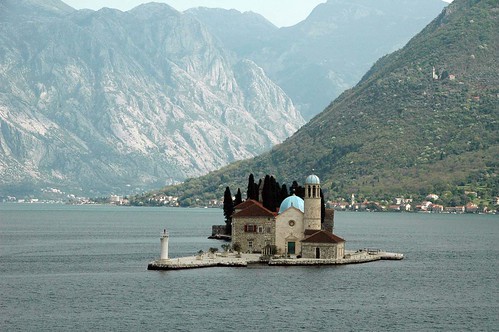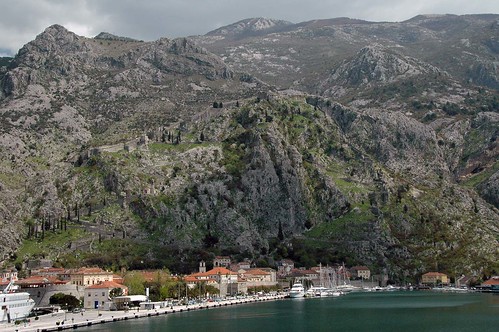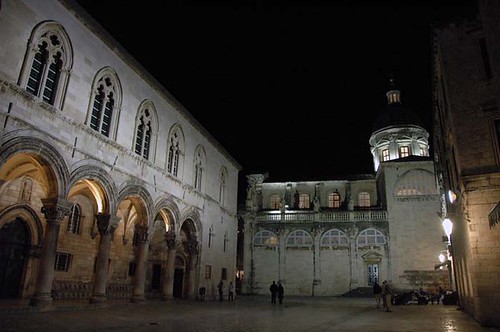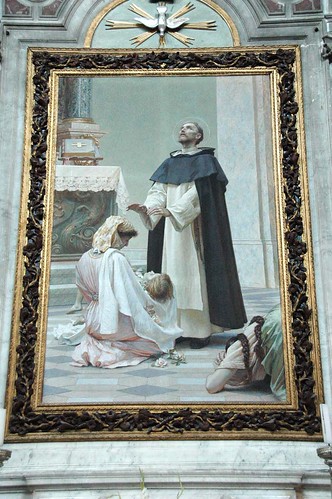Wednesday, April 15, 2009
Kotor, Montenegro and Arrival at Dubrovnik, Croatia
We sail to Kotor, Montenegro. It is a movie set of a town that, like a lot of the towns along the Dalmatian coast, goes back to Neolithic times. As we sail through the narrows, a passage about 300 meters wide, and approach the town dock, I can see a fortress six hundred feet up on the side of Mt. Lovcen. It is the St. John fortress.
In 1420 after being attacked by local clans, Kotor sought Venetian protection. The Venetians built Fort St. John as part of a chain of fortifications raised to fight the Turks.
The moment I lay eyes on it my stomach is in knots. Whenever there is anything high or far or deep when we travel, Nancy will want to go there. I will feel compelled to follow the way a tail follows its dog. The staff is not helping. They describe the view from the top as spectacular. Julie speculates that the fort is anywhere between 900 and 1000 steps. I listen intently. My fate will depend upon whether they are going to sound encouraging or off-putting. They are encouraging. Damn their eyes.
We are to meet at 10:30am behind the Cathedral if we want to go up.
Nancy says, “I’ve been thinking it over. It’s too hard a climb for us. Let’s not go.”
Translated into human speak, that means if we don’t go, I’ll make your life miserable.
“I want to go,” I say, meaning I’d enjoy climbing up that path about as much as I would enjoy chugalugging Milk of Magnesia.
“Are you sure?” says Nancy meaning, I know perfectly well you’d rather swallow glass.
“Couldn’t be surer,” I say as we turn down the tiny street that leads to the beginning of the ordeal.
I suppose if the account of my climb to the top of St. John’s needs a title it would be something like “I get high with a little help from my friends.”
The view is as advertised, a panoramic 270° view of Boca Kotorska, the splendid fjord separating Mt. Lovcen and Mount Orjen. The sky is powder blue and the temperature in the 60°s. There is a flurry of photographs. You’d think we’d conquered Everest.
Onboard the Island Sky, we motor back to the Adriatic Sea and up the southern coastline of Croatia to Dubrovnik, pulling into dock around 7PM. Dubrovnik is Kotor on steroids. Fugitives from Cavtat, a small fishing village that we shall visit tomorrow, founded it. That, in fact, is Cavtat’s major claim to fame. For much of its history Dubrovnik’s ties with Venice were much closer than its ties with cities this side of the Adriatic. During the 15th and 16th centuries it was a major maritime power with over 500 ships under its belt. The discovery of America in 1492 was a major boost to its economy. Venetian dominance lasted 150 years – from 1205 to 1358. When the town achieved formal independence as a city-state in 1382, it called itself the Republic of Ragusa. It may have thrown off Venetian chains, but not Venetian influence.
Ragusa, an Italian word meaning ‘ship’ (the same word as English argosy) has six letters. That may be significant. The number six is Dubrovnik’s unlucky number. On the 6th of April in 1667, an earthquake killed 5,000 of its inhabitants and destroyed so much of the town that it went from a Gothic- and Renaissance-style town with ornate porticoes and overhanging balconies to the straitened face of the Placa Stradun, its main street. Today the treeless avenues, flat-faced facades, and street-floor shops, all compulsory after the earthquake, give the Stradun the look of a shaved head. You can see a hint of what the pre-quake town looked like in the portico of the Sponza Palace or by walking up a side street where overhanging balconies survived the quake.
The second terrible day also involved a six: December 6, 1991, when Slobodan Miloevic and his Yugoslav People’s Army shelled half the houses of the town and a significant number of its monuments. Dubrovnik thought it was out of harm’s way. Who could possibly want to hurt the Pearl of the Adriatic? The local powers had failed to take into account the grandiose desire of Milosevic for a gateway to the sea in his ultimately failed attempt to build a greater Serbia that would unite the Serbs in Bosnia, Croatia, Montenegro, and Serbia. In the end the boundaries of today’s Serbia, rather than expanding, fell back to those of 1878.
The level of cultural achievement in Dubrovnik is apparent in the Dominican Monastery where there are some genuine masterpieces by local artists. The Miracle of St. Dominic by Vlaho Bukovac is one example – a beautifully executed adorational piece in the pre-Raphaelite style.
Nikola Bozidarevic’s triptych is another. The polyptych in the Cathedral of the Assumption of the Virgin is touted as having been painted in Titian’s workshop, perhaps in part by Titian himself. The painting is badly in need of restoration and thus hard to assess. In fact, it is hard to assess a great deal that we have seen. Tours like these are a bit like drive-by shootings. There is no time to stop and smell the irises. I am not disappointed. I consider myself to be window-shopping.
When I find something I really want to buy, I’ll come back.





